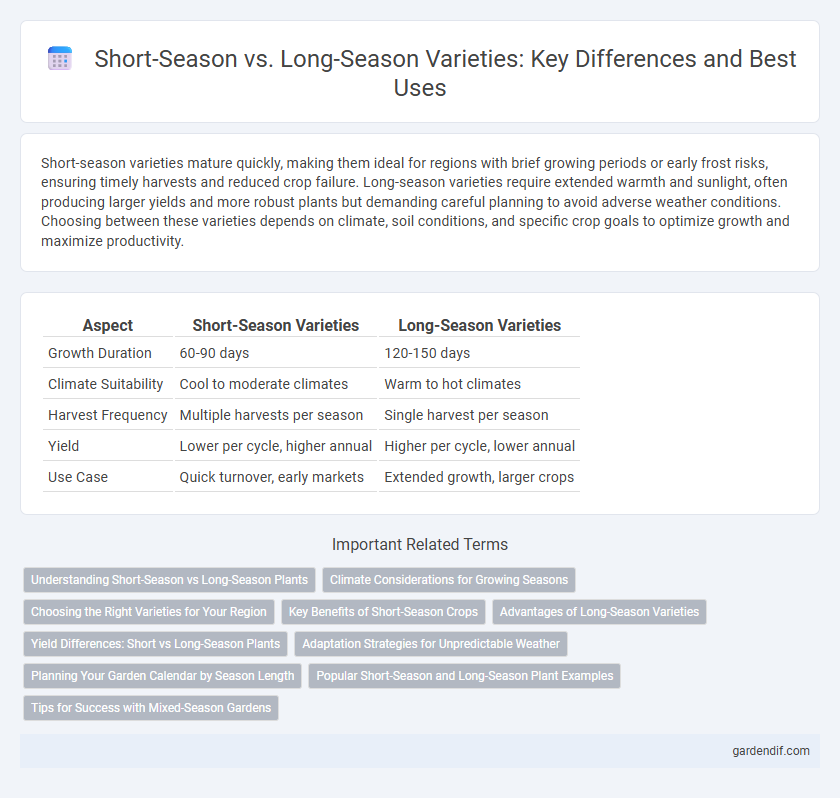
Short-Season Varieties vs Long-Season Varieties Illustration
Short-season varieties mature quickly, making them ideal for regions with brief growing periods or early frost risks, ensuring timely harvests and reduced crop failure. Long-season varieties require extended warmth and sunlight, often producing larger yields and more robust plants but demanding careful planning to avoid adverse weather conditions. Choosing between these varieties depends on climate, soil conditions, and specific crop goals to optimize growth and maximize productivity.
Table of Comparison
| Aspect | Short-Season Varieties | Long-Season Varieties |
|---|---|---|
| Growth Duration | 60-90 days | 120-150 days |
| Climate Suitability | Cool to moderate climates | Warm to hot climates |
| Harvest Frequency | Multiple harvests per season | Single harvest per season |
| Yield | Lower per cycle, higher annual | Higher per cycle, lower annual |
| Use Case | Quick turnover, early markets | Extended growth, larger crops |
Understanding Short-Season vs Long-Season Plants
Short-season varieties mature quickly, typically within 60 to 90 days, making them ideal for regions with shorter growing periods or early frosts. Long-season varieties require extended growing times, often exceeding 100 days, allowing for larger yields and more complex flavors but demanding consistent warm temperatures. Understanding the specific growing requirements and climate adaptability of these plants helps optimize harvest timing and maximize crop success.
Climate Considerations for Growing Seasons
Short-season varieties are ideal for regions with brief growing seasons and unpredictable frosts, as they mature quickly within 60 to 90 days, ensuring crop harvest before adverse weather conditions. Long-season varieties require stable, warmer climates with growing periods extending beyond 100 days, allowing plants to develop fully and produce higher yields under consistent temperature and sunlight conditions. Selecting the appropriate variety based on local climate data minimizes the risk of crop failure and maximizes agricultural productivity.
Choosing the Right Varieties for Your Region
Selecting short-season varieties suits regions with a limited growing period, as they mature quickly and reduce the risk of crop loss due to early frost. Long-season varieties thrive in areas with extended warm weather, producing higher yields and better fruit quality when ample time is available. Matching the variety's growth cycle to your local climate ensures optimal harvest timing and maximizes productivity.
Key Benefits of Short-Season Crops
Short-season crop varieties offer accelerated growth cycles, enabling multiple harvests within a single growing season and maximizing land use efficiency. Their earlier maturation reduces exposure to pests and adverse weather, enhancing crop survival and yield reliability. These varieties are particularly advantageous in regions with limited growing periods or unpredictable climatic conditions, promoting food security and resource optimization.
Advantages of Long-Season Varieties
Long-season varieties offer higher yields due to extended growth periods that maximize photosynthesis and nutrient absorption. These varieties are better suited for regions with reliable, longer growing seasons as they allow crops to reach full maturity, enhancing quality and flavor. Farmers benefit from improved disease resistance and stress tolerance, reducing the need for chemical interventions.
Yield Differences: Short vs Long-Season Plants
Short-season varieties generally produce lower yields compared to long-season varieties due to their abbreviated growth period, limiting biomass accumulation and grain development. Long-season plants maximize photosynthesis duration and resource uptake, resulting in higher overall yield potential. Yield differences are often influenced by climatic conditions and crop management practices tailored to each variety's growing cycle.
Adaptation Strategies for Unpredictable Weather
Short-season varieties offer rapid maturation, enabling crops to avoid late-season frost and drought risks, making them ideal for regions with unpredictable weather patterns. Long-season varieties provide higher yields through extended growth but require stable conditions, necessitating strategic interventions such as soil moisture management and frost protection. Farmers often integrate crop rotation and selective planting windows to maximize resilience against climate variability while maintaining productivity.
Planning Your Garden Calendar by Season Length
Short-season varieties mature faster, typically within 30 to 60 days, making them ideal for regions with brief growing seasons or for fitting multiple crops into a single year. Long-season varieties require 90 to 120 days or more to fully develop, producing larger yields but necessitating careful timing to avoid frost or extreme heat. Understanding your region's frost dates and average growing period is crucial for selecting the appropriate variety and optimizing the garden calendar to maximize productivity.
Popular Short-Season and Long-Season Plant Examples
Popular short-season plant varieties like radishes, lettuce, and peas mature quickly, often within 30 to 60 days, making them ideal for regions with brief growing periods or early spring planting. Long-season varieties such as tomatoes, bell peppers, and pumpkins require 90 to 120 days or more to reach full maturity, benefiting from extended warm weather and consistent care. Selecting between these varieties depends on climate constraints and harvest timing goals to optimize yield and crop quality.
Tips for Success with Mixed-Season Gardens
Selecting the right combination of short-season and long-season varieties allows for continuous harvesting and maximizes garden productivity. Prioritize planting short-season crops like radishes and lettuce early to enjoy quick yields, while integrating long-season plants such as tomatoes and winter squash for later harvests. Maintain consistent soil moisture and monitor frost dates to ensure each variety reaches optimal maturity in mixed-season gardens.
Short-Season Varieties vs Long-Season Varieties Infographic

 gardendif.com
gardendif.com